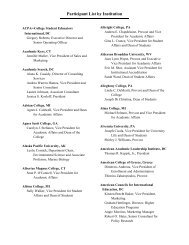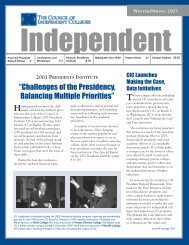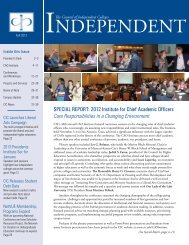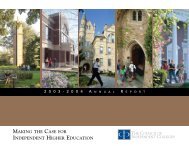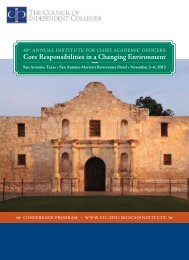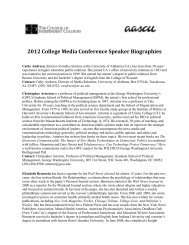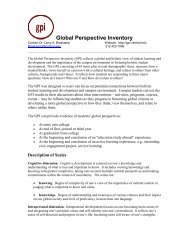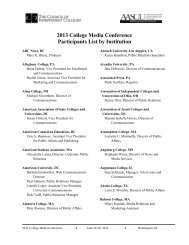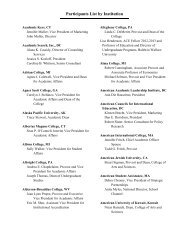Summer 2009 - The Council of Independent Colleges
Summer 2009 - The Council of Independent Colleges
Summer 2009 - The Council of Independent Colleges
Create successful ePaper yourself
Turn your PDF publications into a flip-book with our unique Google optimized e-Paper software.
projects and services<br />
Student Journalists, Presidents Get ‘Inside the Times’<br />
Nearly 100 student news editors from 50 CIC member<br />
colleges and universities participated in the fourth annual<br />
Student Newspaper Editors Workshop at <strong>The</strong> New York Times in<br />
New York City on March 20, <strong>2009</strong>.<br />
<strong>The</strong> event, titled “Inside the Times,” provided student news<br />
editors with the unique opportunity to meet editors and reporters<br />
from the newspaper. Participants explored the role <strong>of</strong> newspapers<br />
in society, discussed all aspects <strong>of</strong> publishing, worked on their<br />
journalistic skills, and met other campus newspaper staffs from<br />
across the country.<br />
During the day, students met with Bill Schmidt, deputy<br />
managing editor; Kathleen McElroy, deputy editor <strong>of</strong> the<br />
continuous news desk; Don Hecker, director <strong>of</strong> the Times’<br />
Student Journalism Institute; Charles Blow, visual op-ed<br />
columnist; and photographer Fred Conrad.<br />
“I found the workshop very intriguing and I learned a lot<br />
that I will be able to bring back to my own newspaper to help<br />
CIC’s <strong>2009</strong> FIT Released; Featured in Business Officer<br />
CIC’s Financial Indicators Tool (FIT) benchmarking<br />
report was recently featured as the cover story in the<br />
April <strong>2009</strong> issue <strong>of</strong> Business Officer magazine, a publication <strong>of</strong><br />
the National Association <strong>of</strong> College and University Business<br />
Officers (NACUBO). “Diagnosing Fiscal Fitness” focuses on<br />
the utility and functionality <strong>of</strong> the FIT by highlighting how<br />
senior administrators <strong>of</strong> Guilford College (NC), Clark Atlanta<br />
University (GA), Ripon College (WI), Friends University (KS),<br />
and the University <strong>of</strong> Puget Sound (WA) use the comparative<br />
benchmarking tool on their campuses. <strong>The</strong> FIT is both a<br />
diagnostic tool—providing useful information about institutional<br />
financial performance—and a resource to assist college leaders<br />
with critical campus planning and decision making tasks.<br />
<strong>The</strong> <strong>2009</strong> edition <strong>of</strong> CIC’s Financial Indicators Tool<br />
(FIT) was released in July. This is the third year that the<br />
financial benchmarking report was prepared for member<br />
presidents. Customized for each member institution, the<br />
annual report provides an assessment <strong>of</strong> financial performance<br />
that is tracked over a six-year period and benchmarked against<br />
similar institutions. Balancing financial performance with<br />
accomplishment <strong>of</strong> mission is key to the utility <strong>of</strong> FIT.<br />
<strong>The</strong> FIT report uses a set <strong>of</strong> financial performance measures<br />
that rely on the Composite Financial Index (CFI), developed<br />
for NACUBO by KPMG, Prager, Sealy & Co., LLC, and<br />
BearingPoint, Inc. <strong>The</strong> CFI is based on four core financial ratios,<br />
each representing a particular domain <strong>of</strong> financial operations: (1)<br />
the primary reserve ratio, indicating resource sufficiency; (2) the<br />
viability ratio as a gauge <strong>of</strong> debt management; (3) the return on<br />
net assets ratio to track financial asset performance; and<br />
improve it as well as help improve myself as a journalist,” said<br />
Ruth Harper, editor-in-chief <strong>of</strong> the St. Bonaventure University<br />
(NY) Bona Venture. Meagan Bemis, editor-in-chief <strong>of</strong> the Eckerd<br />
College (FL) Triton, said “<strong>The</strong> New York Times is all about<br />
integrity, trust, and journalistic skill. It was truly inspiring to<br />
be in the building and hear from the individuals who set the<br />
bar for journalism as a whole.” Bemis added that students were<br />
encouraged “not to take no for an answer.” Instead, “try to learn<br />
from anyone and everything you come in contact with when<br />
seeking jobs in this highly competitive field.”<br />
Presidents will also be <strong>of</strong>fered an inside look at the Times<br />
when the CIC/NYT Partnership hosts a group <strong>of</strong> presidents on<br />
Monday, October 12, <strong>2009</strong>. Participants will meet with reporters<br />
and editors to discuss higher education trends and ideas for future<br />
coverage, as well as plans for the 2010 Student News Editors<br />
Workshop.<br />
(4) the net operating revenues ratio measuring operating results.<br />
<strong>The</strong>se ratios are then standardized, weighted, and combined<br />
into a single index score––the CFI––to indicate the financial<br />
health <strong>of</strong> the institution. Using a scale from -X to 10, the CFI<br />
approach links financial strength with accomplishment <strong>of</strong><br />
mission. <strong>The</strong> threshold for financial health and stability is a score<br />
<strong>of</strong> 3, indicating that an institution has sufficient and adequately<br />
managed resources to fulfill its mission objectives. Scores should<br />
be viewed over a three- to five-year period for the most accurate<br />
portrait <strong>of</strong> financial well being. An average score below 1 is a<br />
concern, suggesting that drastic measures may be necessary to<br />
ensure institutional survival.<br />
<strong>The</strong> FIT is distinctive in two ways. First, it utilizes publicly<br />
available data from the U.S. Department <strong>of</strong> Education’s<br />
Integrated Postsecondary Education Data System (IPEDS), as<br />
well as IRS Form 990s obtained from GuideStar. <strong>The</strong> use <strong>of</strong><br />
these public sources precludes the necessity <strong>of</strong> requiring each<br />
CIC member institution to submit six years <strong>of</strong> audited financial<br />
statements. Second, the FIT provides nationally normed<br />
comparisons similar to those in CIC’s Key Indicators Tool (KIT).<br />
CIC’s FIT is the first financial benchmarking tool to provide<br />
national comparisons using the CFI for any group <strong>of</strong> American<br />
colleges and universities.<br />
<strong>The</strong> U.S. Department <strong>of</strong> Education’s Financial Responsibility<br />
Test, recently featured in news reports <strong>of</strong> colleges that have been<br />
sanctioned, should not be confused with the CFI index used in<br />
CIC’s FIT. <strong>The</strong> Financial Responsibility Test uses a composite<br />
score based upon three ratios, two <strong>of</strong> which are ratios also used in<br />
the CFI, the primary reserve ratio and the net operating revenues<br />
(continued on page 18)<br />
<strong>Independent</strong> | <strong>Summer</strong> <strong>2009</strong> 17



